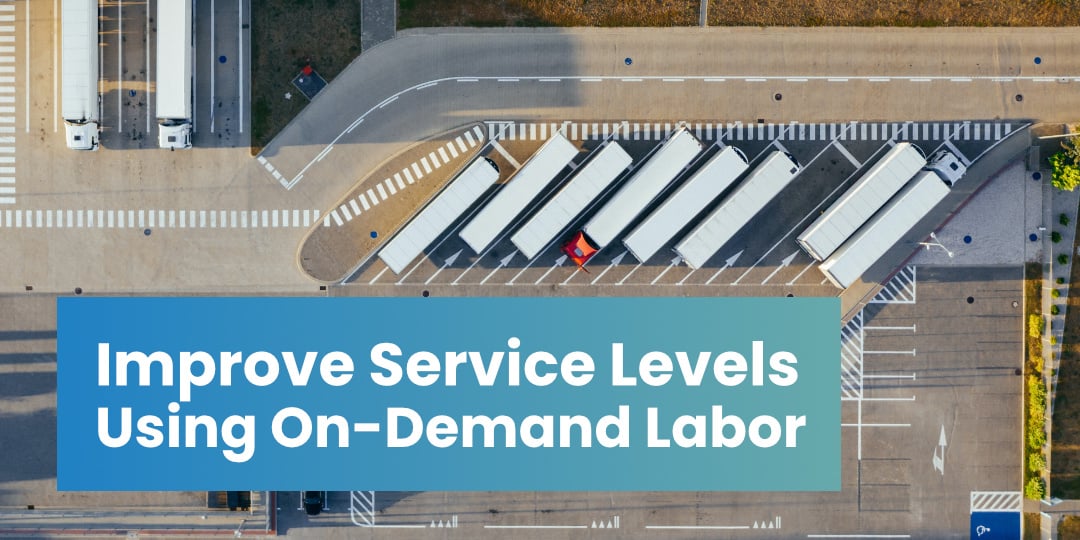Improve Service Levels by Using On-Demand Labor
Most operations leaders know that service is the number one differentiator between suppliers. If you can consistently deliver on time and in full, you will win customers. On the other hand, if you can’t do those things, don’t hold your breath waiting for new customers and don’t expect to keep the ones you have for very long. At Veryable, many companies use our platform to improve their service levels by implementing on-demand labor to respond quickly to firm demand in real time.
In this article, you’ll learn the steps you must take to address service levels and grow beyond the status quo with on-demand labor.
Identify the root cause of your service issues
Nobody wants to be late to customer request. Poor service is usually a symptom of other problems, and it’s in your control to change it. There are areas to attack where you can make a difference, such as equipment bottlenecks, labor constraints, poor scheduling, quality issues, material delays, and agility in responding to volume changes.
You probably already have some idea of where the big drivers of value are in your company, and you should find a way to put resources behind improvements in these areas. It’s crucial that you minimize interruptions to the flow of value through your operation.
This often means addressing a bottleneck, and these bottlenecks can often be elusive.
Recover by addressing the root cause
Technical bottlenecks are easier to spot than “functional bottlenecks.” With a technical bottleneck, you’re typically looking at an asset or a series of assets with a finite amount of capacity that fails to meet your production requirements. In reality, however, most operations are constrained by functional bottlenecks which are the result of some avoidable inefficiency.
These inefficiencies are often the result of variation in demand which can be a matter of chunky order rates or product mix. These variations often cause workcenters to become overloaded temporarily, and that temporary constraint has a ripple effect across the entire process. The key is to quickly identify, or even anticipate, where those constraints are happening and respond quickly to alleviate.
One strategy is to inject incremental capacity on-demand to meet the higher production requirements at that moment in the constrained process. For highest efficiency, you could add workers from your on-demand labor pool to handle tasks that keep your most specialized workers from doing the work that only they can do.
Think of when you go to the orthodontist, technicians do most of the work until the end of the visit, when the orthodontist comes in and does a final inspection of your teeth while dictating notes to the assistant.
This is analogous to if you have a machinist who also typically performs prep and teardown work. You could bring in on-demand labor to assist them with those tasks that are not their core proficiency and value add. This will make your operation more efficient and agile.
Increasing uptime, efficiency, or both will enable you to power through your backlog and clean up overdues. You aren’t out of the woods just yet, because you’ll still likely need to establish a robust operating model that targets real-time bottleneck elimination. That will allow you to reduce lead times, and keep them there, so you don’t end up back where you started.
Improve service continually to gain more ground
It’s tempting to stop when you’ve solved the immediate problem, but you shouldn’t stop there. Continue to prepare for future events by creating flow and reducing your lead times.
Maintaining the status quo would be fine if your forecasts were perfect, but actual demand is always going to be unpredictable. If you don't change anything, you will just slip backwards again.
So recover, prepare yourself to be agile, and once you are agile, you should practice it so that you can take on even more orders and grow. But how do you do this?
Create flow
Creating flow in your operations will allow you to be more responsive to your customers. To do this, you must reduce the amount of work in process (WIP) you have between your workcenters.
It is best practice to calculate a standard amount of WIP as part of a broader standard work strategy. For example, if the cycle time of the operation is five minutes and you are targeting two hours worth of inventory, you would hold 24 pieces prior to that operation.
Doing these calculations at each station will allow you to see where you have more inventory than you need. After you optimize your process to stop producing excess inventory, you might be able to reassign workers to more productive areas and then determine incremental on-demand needs after that recalibration. Use this extra help to continue producing and to flush out this extra inventory.
Reduce lead times
Creating flow and reducing lead times go hand in hand. By creating flow, you’re able to move value to the customer more quickly.
Now that you have optimal work in process, an item introduced to the beginning of the line will flow through more quickly than it did before. Once you gain confidence in this newfound speed, you can reduce your published lead times.
Since this is such a competitive advantage, be ready to see incremental orders coming in. Our benchmarks across all sectors and geographies suggest that every 1% decrease in lead times generates 0.5% increase in orders on average. Certainly an opportunity worth committing to.
And when your line is more responsive, you need to make sure your labor is as well. Your labor pool will allow you to scale up within the line for more output, add shifts to increase your output, and address any labor shortages that put your output or service at risk.
How to implement these improvements quickly
To help with these steps, one option is to implement on-demand labor as a flexible extension of your workforce.
For example, if you suddenly get a big order from a customer, you can add workers from on-demand labor for an incremental shift to capture that demand while maintaining service levels. Then, you can scale back down instantly.
You are always in control of your resourcing in real time with on-demand labor, so there’s no longer a need to hire in waves and then see who sticks before you have to let them go because you’ve caught up to demand. Instead, you can bring in on-demand workers when you have work for them, and stop when there’s no need because you’re keeping pace with your full-time employees.
See how RTIC is able to achieve same day shipments, regardless of volume, with Veryable
How to get started with on-demand labor
To summarize how on-demand labor can help you fix service issues: you can bring in the extra workers you need to increase output, scale back down instantly, and whenever you encounter another surge of demand, you can increase output quickly by bringing on-demand workers from your labor pool to help meet demand.
You can get started with on-demand labor easily by signing up for a free business profile with Veryable.
To learn more about how to improve service levels with on-demand labor, check out these articles:
The First Step to Faster Fulfillment: Mastering Dock-to-Stock Cycle Times
Previous Posts
Why Your Operation Isn’t Too Complex or Specialized for On-Demand Labor
The Future of Manufacturing and Logistics
Create a free business profile today to explore our platform.






